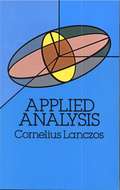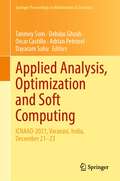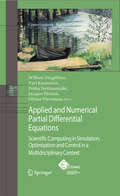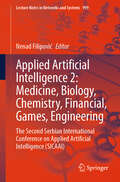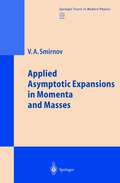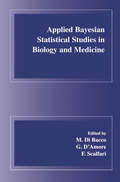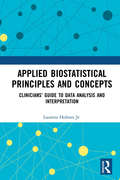- Table View
- List View
Applied Algebra, Algebraic Algorithms and Error-Correcting Codes: 13th International Symposium, AAECC-13 Honolulu, Hawaii, USA, November 15-19, 1999 Proceedings (Lecture Notes in Computer Science #1719)
by Marc Fossorier Hideki Imai Shu Lin Alain PoliThis book constitutes the refereed proceedings of the 19th International Symposium on Applied Algebra, Algebraic Algorithms and Error-Correcting Codes, AAECC-13, held in Honolulu, Hawaii, USA in November 1999.The 42 revised full papers presented together with six invited survey papers were carefully reviewed and selected from a total of 86 submissions. The papers are organized in sections on codes and iterative decoding, arithmetic, graphs and matrices, block codes, rings and fields, decoding methods, code construction, algebraic curves, cryptography, codes and decoding, convolutional codes, designs, decoding of block codes, modulation and codes, Gröbner bases and AG codes, and polynomials.
Applied Analysis (Mathematics and Its Applications #31)
by A.M. KrallApproach your problems from the right end It isn't that they can't see the solution. It is and begin with the answers. Then one day, that they can't see the problem. perhaps you will find the final question. G. K. Chesterton. The Scandal of Father 'The Hermit Clad in Crane Feathers' in R. Brown 'The point of a Pin', van Gu!ik. 'g The Chinese Maze Murders. Growing specialization and diversification have brought a host of monographs and textbooks on increasingly specialized topics. However, the "tree" of knowledge of mathematics and related fields does not grow only by putting forth new branches. It also happens, quite often in fact, that branches which were thought to be completely disparate are suddenly seen to be related. Further, the kind and level of sophistication of mathematics applied in various sciences has changed drastically in recent years: measure theory is used (non-trivially) in regional and theoretical economics; algebraic geometry interacts with physics; the Minkowsky lemma. coding theory and the structure of water meet one another in packing and covering theory; quantum fields, crystal defects and mathematical programming profit from homotopy theory; Lie algebras are relevant to filtering; and prediction and electrical engineering can use Stein spaces. And in addition to this there are such new emerging subdisciplines as "experimental mathematics", "CFD", "completely integrable systems", "chaos, synergetics and large-scale order", which are almost impossible to fit into the existing classification schemes. They draw upon widely different sections of mathematics.
Applied Analysis: Prentice Hall Mathematics Series (Dover Books on Mathematics)
by Cornelius LanczosThis is a basic text for graduate and advanced undergraduate study in those areas of mathematical analysis that are of primary concern to the engineer and the physicist, most particularly analysis and design of finite processes that approximate the solution of an analytical problem. The work comprises seven chapters:Chapter I (Algebraic Equations) deals with the search for roots of algebraic equations encountered in vibration and flutter problems and in those of static and dynamic stability. Useful computing techniques are discussed, in particular the Bernoulli method and its ramifications.Chapter II (Matrices and Eigenvalue Problems) is devoted to a systematic development of the properties of matrices, especially in the context of industrial research.Chapter III (Large-Scale Linear Systems) discusses the "spectroscopic method" of finding the real eigenvalues of large matrices and the corresponding method of solving large-scale linear equations as well as an additional treatment of a perturbation problem and other topics.Chapter IV (Harmonic Analysis) deals primarily with the interpolation aspects of the Fourier series and its flexibility in representing empirically given equidistant data.Chapter V (Data Analysis) deals with the problem of reduction of data and of obtaining the first and even second derivatives of an empirically given function — constantly encountered in tracking problems in curve-fitting problems. Two methods of smoothing are discussed: smoothing in the small and smoothing in the large.Chapter VI (Quadrature Methods) surveys a variety of quadrature methods with particular emphasis on Gaussian quadrature and its use in solving boundary value problems and eignenvalue problems associated with ordinary differential equations.Chapter VII (Power Expansions) discusses the theory of orthogonal function systems, in particular the "Chebyshev polynomials."This unique work, perennially in demand, belongs in the library of every engineer, physicist, or scientist interested in the application of mathematical analysis to engineering, physical, and other practical problems.
Applied Analysis in Biological and Physical Sciences: ICMBAA, Aligarh, India, June 2015 (Springer Proceedings in Mathematics & Statistics #186)
by Jim M. Cushing M. Saleem H. M. Srivastava Mumtaz Ahmad Khan M. MerajuddinThe book contains recent developments and contemporary research in mathematical analysis and in its application to problems arising from the biological and physical sciences. The book is of interest to readers who wish to learn of new research in such topics as linear and nonlinear analysis, mathematical biology and ecology, dynamical systems, graph theory, variational analysis and inequalities, functional analysis, differential and difference equations, partial differential equations, approximation theory, and chaos.All papers were prepared by participants at the International Conference on Recent Advances in Mathematical Biology, Analysis and Applications (ICMBAA-2015) held during 4–6 June 2015 in Aligarh, India. A focal theme of the conference was the application of mathematics to the biological sciences and on current research in areas of theoretical mathematical analysis that can be used as sophisticated tools for the study of scientific problems. The conference provided researchers, academicians and engineers with a platform that encouraged them to exchange their innovative ideas in mathematical analysis and its applications as well as to form interdisciplinary collaborations.The content of the book is divided into three parts: Part I contains contributions from participants whose topics are related to nonlinear dynamics and its applications in biological sciences. Part II has contributions which concern topics on nonlinear analysis and its applications to a variety of problems in science, engineering and industry. Part III consists of contributions dealing with some problems in applied analysis.
Applied Analysis, Optimization and Soft Computing: ICNAAO-2021, Varanasi, India, December 21–23 (Springer Proceedings in Mathematics & Statistics #419)
by Tanmoy Som Debdas Ghosh Oscar Castillo Adrian Petrusel Dayaram SahuThis book contains select contributions presented at the International Conference on Nonlinear Applied Analysis and Optimization (ICNAAO-2021), held at the Department of Mathematics Sciences, Indian Institute of Technology (BHU) Varanasi, India, from 21–23 December 2021. The book discusses topics in the areas of nonlinear analysis, fixed point theory, dynamical systems, optimization, fractals, applications to differential/integral equations, signal and image processing, and soft computing, and exposes the young talents with the newer dimensions in these areas with their practical approaches and to tackle the real-life problems in engineering, medical and social sciences. Scientists from the U.S.A., Austria, France, Mexico, Romania, and India have contributed their research. All the submissions are peer reviewed by experts in their fields.
Applied Analytics through Case Studies Using SAS and R: Implementing Predictive Models and Machine Learning Techniques
by Deepti GuptaExamine business problems and use a practical analytical approach to solve them by implementing predictive models and machine learning techniques using SAS and the R analytical language. This book is ideal for those who are well-versed in writing code and have a basic understanding of statistics, but have limited experience in implementing predictive models and machine learning techniques for analyzing real world data. The most challenging part of solving industrial business problems is the practical and hands-on knowledge of building and deploying advanced predictive models and machine learning algorithms. Applied Analytics through Case Studies Using SAS and R is your answer to solving these business problems by sharpening your analytical skills. What You'll Learn Understand analytics and basic data concepts Use an analytical approach to solve Industrial business problems Build predictive model with machine learning techniquesCreate and apply analytical strategiesWho This Book Is ForData scientists, developers, statisticians, engineers, and research students with a great theoretical understanding of data and statistics who would like to enhance their skills by getting practical exposure in data modeling.
Applied and Computational Matrix Analysis: MAT-TRIAD, Coimbra, Portugal, September 2015 Selected, Revised Contributions (Springer Proceedings in Mathematics & Statistics #192)
by Natália BebianoThis volume presents recent advances in the field of matrix analysis based on contributions at the MAT-TRIAD 2015 conference. Topics covered include interval linear algebra and computational complexity, Birkhoff polynomial basis, tensors, graphs, linear pencils, K-theory and statistic inference, showing the ubiquity of matrices in different mathematical areas.With a particular focus on matrix and operator theory, statistical models and computation, the International Conference on Matrix Analysis and its Applications 2015, held in Coimbra, Portugal, was the sixth in a series of conferences. Applied and Computational Matrix Analysis will appeal to graduate students and researchers in theoretical and applied mathematics, physics and engineering who are seeking an overview of recent problems and methods in matrix analysis.
Applied and Computational Optimal Control: A Control Parametrization Approach (Springer Optimization and Its Applications #171)
by Kok Lay Teo Bin Li Changjun Yu Volker RehbockThe aim of this book is to furnish the reader with a rigorous and detailed exposition of the concept of control parametrization and time scaling transformation. It presents computational solution techniques for a special class of constrained optimal control problems as well as applications to some practical examples. The book may be considered an extension of the 1991 monograph A Unified Computational Approach Optimal Control Problems, by K.L. Teo, C.J. Goh, and K.H. Wong. This publication discusses the development of new theory and computational methods for solving various optimal control problems numerically and in a unified fashion. To keep the book accessible and uniform, it includes those results developed by the authors, their students, and their past and present collaborators. A brief review of methods that are not covered in this exposition, is also included. Knowledge gained from this book may inspire advancement of new techniques to solve complex problems that arise in the future. This book is intended as reference for researchers in mathematics, engineering, and other sciences, graduate students and practitioners who apply optimal control methods in their work. It may be appropriate reading material for a graduate level seminar or as a text for a course in optimal control.
Applied and Industrial Mathematics: Venice - 1, 1989 (Mathematics and Its Applications #56)
by Renato SpiglerVenice-1 symposium on applied and industrial mathematics, 1989
Applied and Industrial Mathematics, Venice—2, 1998: Selected Papers from the ‘Venice—2/Symposium on Applied and Industrial Mathematics’, June 11–16, 1998, Venice, Italy
by Renato SpiglerIn this volume, I have collected several papers which were presented at the international conference called "Venice-2/Symposium on Applied and In dustrial Mathematics". Such a conference was held in Venice, Italy, between June 11 and 16,1998, and was intended as the follow-up of the very successful similar event (called "Venice-1/Symposium on Applied and Industrial Math ematics"), that was also organized in Venice in October 1989. The Venice-1 conference ended up with a Kluwer volume like this one. I am grateful to Kluwer for having accepted to publish the present volume, the aim of which is to update somehow the state-of-the-art in the field of Ap plied Mathematics as well as in that of the nowadays rather more developed area of Industrial Mathematics. The most of the invited (key-note) speakers contributed to this volume with a paper related to their talk. There are, in addition·, a few significant contributed papers, selected on the basis of their quality and relevance to the present-time research activities. The topics considered in the conference range from rather general sub jects in applied and numerical analysis, to more specialized subjects such as polymers and disordered media, granular flow, semiconductor mathematics, superconductors, elasticity, tomography and other inverse problems, financial modeling, photographic sciences, etc. The papers collected in this volume provide a selection of them. It is clear from the previous list that some attention has been paid to relatively new and emerging fields.
Applied and Numerical Partial Differential Equations: Scientific Computing in Simulation, Optimization and Control in a Multidisciplinary Context (Computational Methods in Applied Sciences #15)
by W. Fitzgibbon Y. A. Kuznetsov Pekka Neittaanmäki Jacques Périaux Olivier PironneauApplied Artificial Intelligence 2: The Second Serbian International Conference on Applied Artificial Intelligence (SICAAI) (Lecture Notes in Networks and Systems #999)
by Nenad FilipovićThe book Applied Artificial Intelligence 2: Medicine, Biology, Chemistry, Financial, Games, Engineering is providing exceptional chapters of the state-of-the-art research knowledge and results on the innovative theories, methodology and applications of artificial intelligence and its sub-domain like deep learning, machine learning in different areas such as medicine, economy, education, law, smart city, government, industry etc. Innovative research ideas on how to solve problems using artificial intelligence, both in R&D and real-time applications are presented. Chapters describe the advanced prototypes, systems, methodologies, tools and techniques and general survey papers, which indicate future directions. These Chapters are extended papers from the Second Serbian International Conference on Applied Artificial Intelligence (SICAAI), which was held in Kragujevac, Serbia, on May 19-20, 2023
Applied Asset and Risk Management: A Guide to Modern Portfolio Management and Behavior-Driven Markets (Management for Professionals)
by Marcus Schulmerich Yves-Michel Leporcher Ching-Hwa EuThis book is a guide to asset and risk management from a practical point of view. It is centered around two questions triggered by the global events on the stock markets since the middle of the last decade: - Why do crashes happen when in theory they should not? - How do investors deal with such crises in terms of their risk measurement and management and as a consequence, what are the implications for the chosen investment strategies? The book presents and discusses two different approaches to finance and investing, i.e., modern portfolio theory and behavioral finance, and provides an overview of stock market anomalies and historical crashes. It is intended to serve as a comprehensive introduction to asset and risk management for bachelor’s and master’s students in this field as well as for young professionals in the asset management industry. A key part of this book is the exercises to further demonstrate the concepts presented with examples and a step-by-step business case. An Excel file with the calculations and solutions for all 17 examples as well as all business case calculations can be downloaded at extras.springer.com.
Applied Asymptotic Expansions in Momenta and Masses (Springer Tracts in Modern Physics #177)
by Vladimir A. Smirnov'The sturgeon they sent was second grade fresh,' said the barman. 'Really, what nonsense/' 'Why nonsense?' '"Second grade fresh" that's what I call nonsense/ There's only one degree of freshness the first, and it's the last) (M. A. Bulgakov, The Master and Margarita) The goal of this book is to describe in detail how Feynman integrals can be expanded in suitable parameters, when various momenta or masses are small or large. In a narrow sense, this problem is connected with practical calcula tions. In a situation where a given Feynman integral depends on parameters of very different scales, a natural idea is to replace it by a sufficiently large number of terms of an expansion of it in ratios of small and large scales. It will be explained how this problem of expansion can be systematically solved, by formulating universal prescriptions that express terms of the expansion by using the original Feynman integral with its integrand expanded into a Taylor series in appropriate momenta and masses. It turns out that knowledge of the structure of the asymptotic expansion at the diagrammatic level is a key point in understanding how to perform expansions at the operator level. There are various examples of these ex pansions: the operator product expansion, the large mass expansion, Heavy Quark Effective Theory, Non Relativistic QCD, etc. Each of them serves as a realization of the factorization of contributions of different scales.
Applied Asymptotic Methods in Nonlinear Oscillations (Solid Mechanics and Its Applications #55)
by Yuri A. Mitropolsky Nguyen Van DaoMany dynamical systems are described by differential equations that can be separated into one part, containing linear terms with constant coefficients, and a second part, relatively small compared with the first, containing nonlinear terms. Such a system is said to be weakly nonlinear. The small terms rendering the system nonlinear are referred to as perturbations. A weakly nonlinear system is called quasi-linear and is governed by quasi-linear differential equations. We will be interested in systems that reduce to harmonic oscillators in the absence of perturbations. This book is devoted primarily to applied asymptotic methods in nonlinear oscillations which are associated with the names of N. M. Krylov, N. N. Bogoli ubov and Yu. A. Mitropolskii. The advantages of the present methods are their simplicity, especially for computing higher approximations, and their applicability to a large class of quasi-linear problems. In this book, we confine ourselves basi cally to the scheme proposed by Krylov, Bogoliubov as stated in the monographs [6,211. We use these methods, and also develop and improve them for solving new problems and new classes of nonlinear differential equations. Although these methods have many applications in Mechanics, Physics and Technique, we will illustrate them only with examples which clearly show their strength and which are themselves of great interest. A certain amount of more advanced material has also been included, making the book suitable for a senior elective or a beginning graduate course on nonlinear oscillations.
Applied Bayesian and Classical Inference: The Case of The Federalist Papers (Springer Series in Statistics)
by F. Mosteller D. L. WallaceThe new version has two additions. First, at the suggestion of Stephen Stigler I we have replaced the Table of Contents by what he calls an Analytic Table of Contents. Following the title of each section or subsection is a description of the content of the section. This material helps the reader in several ways, for example: by giving a synopsis of the book, by explaining where the various data tables are and what they deal with, by telling what theory is described where. We did several distinct full studies for the Federalist papers as well as many minor side studies. Some or all may offer information both to the applied and the theoretical reader. We therefore try to give in this Contents more than the few cryptic words in a section heading to ~peed readers in finding what they want. Seconq, we have prepared an extra chapter dealing with authorship work published from. about 1969 to 1983. Although a chapter cannot compre hensively Gover a field where many books now appear, it can mention most ofthe book-length works and the main thread of authorship' studies published in English. We founq biblical authorship studies so extensive and com plicated that we thought it worthwhile to indicate some papers that would bring out the controversies that are taking place. We hope we have given the flavor of developments over the 15 years mentioned. We have also corrected a few typographical errors.
Applied Bayesian Forecasting and Time Series Analysis (Chapman & Hall/CRC Texts in Statistical Science)
by Andy Pole Mike West Jeff HarrisonPractical in its approach, Applied Bayesian Forecasting and Time Series Analysis provides the theories, methods, and tools necessary for forecasting and the analysis of time series. The authors unify the concepts, model forms, and modeling requirements within the framework of the dynamic linear mode (DLM). They include a complete theoretical development of the DLM and illustrate each step with analysis of time series data. Using real data sets the authors: Explore diverse aspects of time series, including how to identify, structure, explain observed behavior, model structures and behaviors, and interpret analyses to make informed forecasts Illustrate concepts such as component decomposition, fundamental model forms including trends and cycles, and practical modeling requirements for routine change and unusual events Conduct all analyses in the BATS computer programs, furnishing online that program and the more than 50 data sets used in the text The result is a clear presentation of the Bayesian paradigm: quantified subjective judgements derived from selected models applied to time series observations. Accessible to undergraduates, this unique volume also offers complete guidelines valuable to researchers, practitioners, and advanced students in statistics, operations research, and engineering.
Applied Bayesian Modeling and Causal Inference from Incomplete-Data Perspectives (Wiley Series in Probability and Statistics)
by Donald B. Rubin Andrew Gelman Xiao-Li MengThis book brings together a collection of articles on statistical methods relating to missing data analysis, including multiple imputation, propensity scores, instrumental variables, and Bayesian inference. Covering new research topics and real-world examples which do not feature in many standard texts. The book is dedicated to Professor Don Rubin (Harvard). Don Rubin has made fundamental contributions to the study of missing data. Key features of the book include: Comprehensive coverage of an imporant area for both research and applications. Adopts a pragmatic approach to describing a wide range of intermediate and advanced statistical techniques. Covers key topics such as multiple imputation, propensity scores, instrumental variables and Bayesian inference. Includes a number of applications from the social and health sciences. Edited and authored by highly respected researchers in the area.
Applied Bayesian Modelling (Wiley Series in Probability and Statistics #595)
by Peter CongdonThis book provides an accessible approach to Bayesian computing and data analysis, with an emphasis on the interpretation of real data sets. Following in the tradition of the successful first edition, this book aims to make a wide range of statistical modeling applications accessible using tested code that can be readily adapted to the reader's own applications. The second edition has been thoroughly reworked and updated to take account of advances in the field. A new set of worked examples is included. The novel aspect of the first edition was the coverage of statistical modeling using WinBUGS and OPENBUGS. This feature continues in the new edition along with examples using R to broaden appeal and for completeness of coverage.
Applied Bayesian Modelling (Wiley Series in Probability and Statistics #595)
by Peter CongdonThis book provides an accessible approach to Bayesian computing and data analysis, with an emphasis on the interpretation of real data sets. Following in the tradition of the successful first edition, this book aims to make a wide range of statistical modeling applications accessible using tested code that can be readily adapted to the reader's own applications. The second edition has been thoroughly reworked and updated to take account of advances in the field. A new set of worked examples is included. The novel aspect of the first edition was the coverage of statistical modeling using WinBUGS and OPENBUGS. This feature continues in the new edition along with examples using R to broaden appeal and for completeness of coverage.
Applied Bayesian Statistical Studies in Biology and Medicine
by F. Scalfari M. Di Bacco G. D'AmoreThis volume presents the results of biological and medical research with the statistical methods used to obtain them. Nowadays the fields of biology and experimental medicine rely on techniques for processing of experimental data and for the evaluation of hypotheses. It is increasingly necessary to stimulate awareness of the importance of statistical techniques (and of the possible traps that they can hide) by using real data in concrete situations drawn from research activity.
Applied Bayesian Statistics: With R and OpenBUGS Examples (Springer Texts in Statistics #98)
by Mary Kathryn CowlesThis book is based on over a dozen years teaching a Bayesian Statistics course. The material presented here has been used by students of different levels and disciplines, including advanced undergraduates studying Mathematics and Statistics and students in graduate programs in Statistics, Biostatistics, Engineering, Economics, Marketing, Pharmacy, and Psychology. The goal of the book is to impart the basics of designing and carrying out Bayesian analyses, and interpreting and communicating the results. In addition, readers will learn to use the predominant software for Bayesian model-fitting, R and OpenBUGS. The practical approach this book takes will help students of all levels to build understanding of the concepts and procedures required to answer real questions by performing Bayesian analysis of real data. Topics covered include comparing and contrasting Bayesian and classical methods, specifying hierarchical models, and assessing Markov chain Monte Carlo output. Kate Cowles taught Suzuki piano for many years before going to graduate school in Biostatistics. Her research areas are Bayesian and computational statistics, with application to environmental science. She is on the faculty of Statistics at The University of Iowa.
Applied Biclustering Methods for Big and High-Dimensional Data Using R (Chapman & Hall/CRC Biostatistics Series)
by Adetayo Kasim Ziv Shkedy Sebastian Kaiser Sepp Hochreiter Willem TalloenProven Methods for Big Data Analysis As big data has become standard in many application areas, challenges have arisen related to methodology and software development, including how to discover meaningful patterns in the vast amounts of data. Addressing these problems, Applied Biclustering Methods for Big and High-Dimensional Data Using R shows how to apply biclustering methods to find local patterns in a big data matrix. The book presents an overview of data analysis using biclustering methods from a practical point of view. Real case studies in drug discovery, genetics, marketing research, biology, toxicity, and sports illustrate the use of several biclustering methods. References to technical details of the methods are provided for readers who wish to investigate the full theoretical background. All the methods are accompanied with R examples that show how to conduct the analyses. The examples, software, and other materials are available on a supplementary website.
Applied Biostatistical Principles and Concepts: Clinicians' Guide to Data Analysis and Interpretation
by Laurens Holmes, Jr.The past three decades have witnessed modern advances in statistical modeling and evidence discovery in biomedical, clinical, and population-based research. With these advances come the challenges in accurate model stipulation and application of models in scientific evidence discovery Applied Biostatistical Principles and Concepts provides practical knowledge using biological and biochemical specimen/samples in order to understand health and disease processes at cellular, clinical, and population levels. Concepts and techniques provided will help researchers design and conduct studies, then translate data from bench to clinics in attempt to improve the health of patients and populations. This book is suitable for both clinicians and health or biological sciences students. It presents the reality in statistical modelling of health research data in a concise manner that will address the issue of "big data" type I error tolerance and probability value, effect size and confidence interval for precision, effect measure modification and interaction as well as confounders, thus allowing for more valid inferences and yielding results that are more reliable, valid and accurate.
Applied Biostatistical Principles and Concepts: Clinicians' Guide to Data Analysis and Interpretation
by Laurens Holmes, Jr.The past three decades have witnessed modern advances in statistical modeling and evidence discovery in biomedical, clinical, and population-based research. With these advances come the challenges in accurate model stipulation and application of models in scientific evidence discovery Applied Biostatistical Principles and Concepts provides practical knowledge using biological and biochemical specimen/samples in order to understand health and disease processes at cellular, clinical, and population levels. Concepts and techniques provided will help researchers design and conduct studies, then translate data from bench to clinics in attempt to improve the health of patients and populations. This book is suitable for both clinicians and health or biological sciences students. It presents the reality in statistical modelling of health research data in a concise manner that will address the issue of "big data" type I error tolerance and probability value, effect size and confidence interval for precision, effect measure modification and interaction as well as confounders, thus allowing for more valid inferences and yielding results that are more reliable, valid and accurate.


